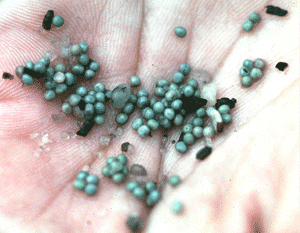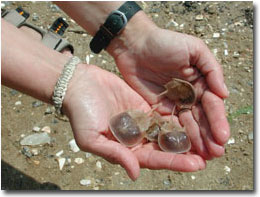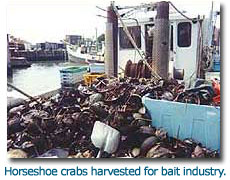We Ain't Nothing but Arthropods!
Life Cycle/Reproduction
Egg/Larvae Stage
 Horseshoe crab eggs are buried higher up on
sandy beaches in nests made by the female
horseshoes. Temperatures vary here in
the moist sand. Each nest normally
contain approximately 4,000 eggs! An
egg's size can be compared to a pinhead. Once the egg breaks due to either age,
hatching, or sand abrasion, the larvae will
emerge!
Horseshoe crab eggs are buried higher up on
sandy beaches in nests made by the female
horseshoes. Temperatures vary here in
the moist sand. Each nest normally
contain approximately 4,000 eggs! An
egg's size can be compared to a pinhead. Once the egg breaks due to either age,
hatching, or sand abrasion, the larvae will
emerge!
Horseshoe Crab eggs.
Photo by Greg Breese, USFWS
Juvenile
 In
order for arthropods to grow they need to
molt. Approximately 20 days after the
egg hatched, the larvae will molt for the
first time. At a young age the
horseshoe crab will molt many times
throughout the first year of its life. As
the crab ages it will molt about once a
year. During this stage of its life, it spends
the first couple years in the intertidal
flats. As it gets closer to the adult
stage it will move out to deeper waters.
In
order for arthropods to grow they need to
molt. Approximately 20 days after the
egg hatched, the larvae will molt for the
first time. At a young age the
horseshoe crab will molt many times
throughout the first year of its life. As
the crab ages it will molt about once a
year. During this stage of its life, it spends
the first couple years in the intertidal
flats. As it gets closer to the adult
stage it will move out to deeper waters.
Above: Two year old
horseshoe crabs raised in Maryland
classrooms.
Below: A picture of a male and female
spawning.
Adult/Spawning Stage
When the horseshoe crab reaches the adult
stage and sexual maturity, it moves back
toward the sandy beaches. It then
begins its annual spawning migration.
By the time spawning season starts, the
female horseshoe crab will have produced
approximately
80,000
eggs! When the hors eshoe
crabs leave the deep end for the shore, the
males actually walk along the beaches,
almost like they are patrolling, patiently
waiting for the females. When the
females arrive, they gives off pheromones
which is a chemical that the males can
detect. Once detected the males
basically attend the females to the beach.
Many times a single female horseshoe crab
will get surrounded by
multiple males, typically around five or six.
After the nest is made and one clutch
(~4,000 eggs) is laid by the female, the
males grasp onto the back of the female then
it lays its sperm onto the eggs. Each
spawning season a female will lay about 20
clusters. This spawning process is
repeated every year until the death of the
horseshoe crab.
eshoe
crabs leave the deep end for the shore, the
males actually walk along the beaches,
almost like they are patrolling, patiently
waiting for the females. When the
females arrive, they gives off pheromones
which is a chemical that the males can
detect. Once detected the males
basically attend the females to the beach.
Many times a single female horseshoe crab
will get surrounded by
multiple males, typically around five or six.
After the nest is made and one clutch
(~4,000 eggs) is laid by the female, the
males grasp onto the back of the female then
it lays its sperm onto the eggs. Each
spawning season a female will lay about 20
clusters. This spawning process is
repeated every year until the death of the
horseshoe crab.
Atlantic Horseshoe Crab Life Cycle
This lifecycle I created myself referencing from http://www.horseshoecrab.org/
Mortality
There are multiple causes for the death of
horseshoe crabs. Beach stranding,
diseases, and predation fall under the
natural death category. The bait
fishin g industry is another major cause of
death. Approximately 2.7 million crabs
are killed due to harvesting them for eel
and conch bait. The last major cause
of death is due to our own medicinal
purposes. Between 20-40 thousand
horseshoe crabs die due to drawing too much
of their blood. To learn more about
harvesting horseshoe crabs visit
http://dnr.maryland.gov/education/horseshoecrab/.
g industry is another major cause of
death. Approximately 2.7 million crabs
are killed due to harvesting them for eel
and conch bait. The last major cause
of death is due to our own medicinal
purposes. Between 20-40 thousand
horseshoe crabs die due to drawing too much
of their blood. To learn more about
harvesting horseshoe crabs visit
http://dnr.maryland.gov/education/horseshoecrab/.
To learn about the horseshoe crab's interactions with other organisms click here!
To go back to the Nutrition page click here.
To go back to the home page click here.
